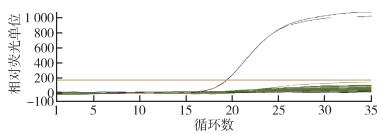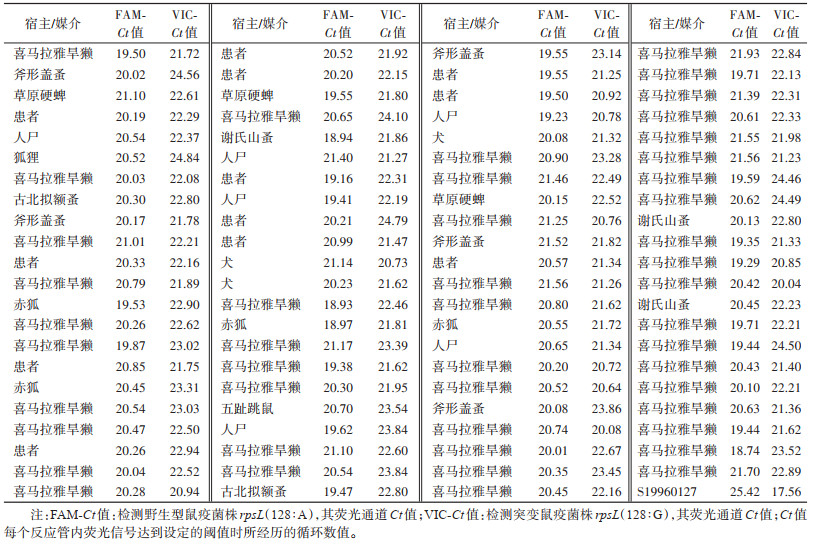扩展功能
文章信息
- 李胜, 靳娟, 何建, 张琪, 杨晓艳, 辛有全, 赵海红, 张晓璐, 柏吉祥, 代瑞霞
- LI Sheng, JIN Juan, HE Jian, ZHANG Qi, YANG Xiao-yan, XIN You-quan, ZHAO Hai-hong, ZHANG Xiao-lu, BAI Ji-xiang, DAI Rui-xia
- 应用TaqMan-MGB探针RT-qPCR技术对青海省海南州鼠疫菌耐链霉素rpsL基因突变位点的检测
- Detection of streptomycin-resistant rpsL gene mutations in Yersinia pestis in Hainan prefecture, Qinghai province, China using quantitative real-time PCR with TaqMan-MGB probes
- 中国媒介生物学及控制杂志, 2023, 34(3): 331-335
- Chin J Vector Biol & Control, 2023, 34(3): 331-335
- 10.11853/j.issn.1003.8280.2023.03.009
-
文章历史
- 收稿日期: 2022-12-13
鼠疫是由鼠疫耶尔森菌(Yersinia pestis,鼠疫菌)引起的一种自然疫源性传染病,在《中华人民共和国传染病防治法》中列为甲类传染病,鼠疫的流行曾给人类带来巨大的灾难[1-2]。因此,鼠疫防控对国家安全、社会和谐稳定至关重要。抗生素问世之前,人们对治疗鼠疫往往束手无策,随着抗生素的发现和应用,鼠疫治疗进入了新的时期,特别是链霉素问世后,彻底解决了鼠疫治疗的问题[3]。目前,国内外鼠疫患者的治疗仍以链霉素为首选特效药物,降低了病死率提高了治愈率。但是,1995年马达加斯加分离1株质粒(pIP1202)介导的多重耐药菌株(17/95),其对链霉素有高水平的耐药性[最低抑菌浓度(MICs) > 2 048 mg/L],主要与携带耐链霉素strA、strB基因有关[4]。2001年Guiyoule等[5]在马达加斯加报道了1株质粒(pIP1203)介导的对链霉素具有高抗性的鼠疫菌株(16/95),此质粒仅带有strA、strB耐药基因,能高频结合到其他鼠疫菌。迄今为止,我国未见报道携带耐链霉素strA、strB基因的鼠疫菌株[6-8],有研究证实我国存在耐链霉素鼠疫菌株,主要是核糖体蛋白S12编码基因(rpsL基因)发生突变引起的[9]。耐药鼠疫菌株的出现对鼠疫的传统治疗方案提出了新的挑战。因此,本研究利用TaqMan-MGB探针技术对青海省海南藏族自治州(海南州)鼠疫疫源地87株鼠疫菌进行了耐链霉素rpsL基因突变位点检测,为该地区的鼠疫精准防控提供科学依据。
1 材料与方法 1.1 材料 1.1.1 实验菌株选取1954-2009年间海南州鼠疫疫源地内不同时间、不同地点分离的鼠疫菌株,共87株。其中从喜马拉雅旱獭(Marmota himalayana)、犬、狐狸等宿主动物体内分离57株,鼠疫患者及人尸体内分离17株,媒介蚤、蜱和虱体内共分离13株。所有菌株均由青海省地方病预防控制所保存。
1.1.2 实验菌株培养及DNA提取将被试菌株培养于赫氏琼脂培养基,28 ℃培养24 h,经鼠疫菌特异性噬菌体裂解试验鉴定后,采用传统的苯酚-氯仿混合抽提法提取菌株DNA[10]。
1.1.3 主要仪器及试剂Real-time Thermal Cycler购自美国赛默飞世尔科技有限公司(型号:5100)。TransStart Probe qPCR SuperMix购自全式金生物技术有限公司,PCR产物纯化试剂盒购自北京诺博莱德科技有限公司。MGB荧光探针及引物由上海辉睿生物科技有限公司合成,引物序列见表 1(引物参照CO92基因组,其在GenBank中的编号:NZ_CP009973.1,位置:215373)。
以野生型鼠疫菌株和S19960127鼠疫菌株[9]rpsL基因位点分别设计羧基荧光素(FAM)探针和亚磷酰胺(VIC)探针,主要用于检测被试菌株基因序列第128位的碱基突变(A→G),其目的是在所有被试菌株中筛查出rpsL基因发生突变的耐链霉素鼠疫菌株。
1.2.2 TaqMan-MGB荧光探针法PCR反应体系为20 μl,含TransStart Probe qPCR SuperMix 10 μl、正反向引物各1 μl(浓度为0.1 μmol/L),0.1 μmol/L rpsL野生型和突变型基因第128位密码子MGB探针各1 μl,去离子水5 μl,DNA模板1 μl(浓度2 ng/μl)。反应条件:94 ℃预变性5 min;95 ℃变性15 s,58 ℃延伸30 s,扩增40个循环。S19960127鼠疫菌株为阳性对照,ddH2O为阴性对照。
2 结果87株被试菌株的FAM检测结果均为阳性,其对应检测rpsL(128∶A),每个反应管内荧光信号达到设定的阈值时所经历的循环数(Ct)值在18.74~21.93,相对荧光单位(relative fluorescence units,RFU)峰值> 2 000;S19960127的Ct值为25.42,RFU峰值< 200;阴性对照RFU峰值< 200。所有被试菌株VIC检测结果均为阴性,其对应检测rpsL(128∶G),Ct值在20.04~24.79,RFU峰值< 200;S19960127的Ct值为17.56,RFU峰值> 1 000,阴性对照的RFU峰值< 200。实验结果显示海南州鼠疫疫源地87株鼠疫菌基因序列第128位的碱基均为A碱基,未发生A→G的突变。见图 1、2,表 2。

|
| 注:红色曲线为阳性对照,绿色曲线为被试菌株,黑色曲线为阴性对照。 图 1 部分鼠疫菌菌株羧基荧光素(FAM)荧光检测结果 Figure 1 Fluorescence results with carboxyfluorescein probes for some strains of Yersinia pestis |
| |

|
| 注:红色曲线为阳性对照,绿色曲线为被试菌株,黑色曲线为阴性对照。 图 2 部分鼠疫菌菌株亚磷酰胺(VIC)荧光检测结果 Figure 2 Fluorescence results with VIC probes for some strains of Yersinia pestis |
| |

|
历史上曾发生过3次人间鼠疫的世界性大流行,给人类带来巨大的灾难。我国存在着世界上面积最大、结构复杂的鼠疫自然疫源地,现已判定的鼠疫自然疫源地有12块,占国土总面积的15%左右[11]。青海省海南州于1954年判定为鼠疫疫源地,是青海省最早判定的鼠疫疫源地,其属于青藏高原喜马拉雅旱獭鼠疫自然疫源地。喜马拉雅旱獭鼠疫疫源地是我国鼠疫疫源面积最大的一块疫源地,也是动物间鼠疫和人间鼠疫流行最严重的疫源地之一[12]。海南州自判定为鼠疫疫源地以来,该地区的动物间和人间鼠疫疫情持续不断,20世纪60、70年代鼠疫疫情流行较为严重,80、90年代鼠疫病例有所减少[13-14]。进入21世纪后该疫源地发生2起人间鼠疫疫情,其中2009年兴海县暴发一起人间肺鼠疫疫情,发病12例,死亡3例,其对青海省经济稳定和社会和谐发展造成了巨大影响[15]。2009年至今该地区未分离到鼠疫菌,鼠疫疫情较为平稳,不排除该疫源地鼠疫流行可能进入静息时期,但长期静息的疫源地一旦转入活跃期,很可能会造成鼠疫突发公共卫生事件。因此,该地区的鼠疫防控工作不容忽视。
链霉素作为治疗鼠疫的首选抗生素,广泛应用于世界各个鼠疫疫源地区鼠疫患者的治疗。自链霉素应用于鼠疫临床治疗后,鼠疫患者治愈率明显上升,病死率由50%~90%降低到5%以下[16]。但Dai等[9]发现1996年从我国西藏自治区山南地区一起肺鼠疫疫情暴发中分离的1株鼠疫菌(S19960127),对链霉素高度耐药,与国外既往报道[4-5]由质粒介导的链霉素耐药性不同,是由一种新的耐药机制即rpsL基因突变导致的耐药。青海省和西藏自治区鼠疫疫源地均属于青藏高原喜马拉雅旱獭鼠疫自然疫源地,该疫源地鼠疫菌株大多属于青藏高原型菌株,其毒力因子俱全,毒力强,临床病例多以肺鼠疫或败血型多见[17-18]。该疫源地鼠疫患者若不及时给予治疗可能导致病情恶化而死亡,或继而引发人间鼠疫疫情的暴发流行。链霉素作为鼠疫临床治疗的首选特效药物,一旦出现耐药,会对鼠疫病例的救治和疫情防控工作造成困扰。因此,对该疫源地鼠疫菌进行链霉素敏感性筛查迫在眉睫。
实时荧光定量PCR(RT-qPCR)是一种用于实时扩增和检测特定DNA或RNA序列的分子生物学技术。本研究中RT-qPCR利用MGB荧光探针,对目标序列进行量化。TaqMan-MGB探针中采用了非荧光淬灭基团和MGB修饰基团,通过降低PCR反应荧光本底信号强度,缩短探针所需的碱基序列进一步提高了此方法的特异性和灵敏度。MGB探针在错配碱基的识别与信噪比方面,也都优于其他荧光探针[19]。本研究中利用S19960127菌株rpsL基因突变位点和野生型鼠疫菌株rpsL基因位点分别设计探针,利用TaqMan-MGB探针技术对海南州1954-2009年分离的87株鼠疫菌进行了耐链霉素rpsL基因突变位点检测,结果未发现耐链霉素鼠疫菌株,说明该疫源地分离的鼠疫菌对链霉素均敏感。目前,耐药细菌的产生,很大程度上归因于人类滥用及不适当使用抗菌药物,而且细菌的耐药基因可以通过质粒、转座子在细菌同种或不同种属间进行基因水平转移,使细菌的耐药性在病原菌中广泛传播[20]。虽然本次研究中选择的87株代表性鼠疫菌株对链霉素均敏感,但不排除该疫源地今后有耐链霉素鼠疫菌株的存在。因此,只有持续监测鼠疫菌耐药性并建立该地区鼠疫菌耐药性监测网络,才能及时发现并控制耐药菌的传播。本研究中的TaqMan-MGB探针技术可准确、快速地进行耐链霉素鼠疫菌株的早期检测,为突发鼠疫疫情提供更精准的鼠疫防控策略。
利益冲突 无
| [1] |
丛显斌, 徐成, 张贵军. 中国鼠疫疫情现状[J]. 中国地方病防治杂志, 2006, 21(3): 159-163. Cong XB, Xu C, Zhang GJ. Current situation of plague epidemic in China[J]. Chin J Ctrl Endem Dis, 2006, 21(3): 159-163. DOI:10.3969/j.issn.1001-1889.2006.03.013 |
| [2] |
周冬生, 杨瑞馥. 鼠疫研究进展与展望[J]. 解放军医学杂志, 2010, 35(10): 1176-1182. Zhou DS, Yang RF. Progress and prospect of research work on plague[J]. Med J Chin Peoples Liberat Army, 2010, 35(10): 1176-1182. |
| [3] |
张贵, 张贵军, 刘振才. 抗生素治疗鼠疫的现状及进展[J]. 中国地方病学杂志, 2006, 25(6): 729-730. Zhang G, Zhang GJ, Liu ZC. Current situation and progress of antibiotic therapy for plague[J]. Chin J Endemiol, 2006, 25(6): 729-730. DOI:10.3760/cma.j.issn.1000-4955.2006.06.056 |
| [4] |
Galimand M, Guiyoule A, Gerbaud G, et al. Multidrug resistance in Yersinia pestis mediated by a transferable plasmid[J]. N Engl J Med, 1997, 337(10): 677-681. DOI:10.1056/NEJM199709043371004 |
| [5] |
Guiyoule A, Gerbaud G, Buchrieser C, et al. Transferable plasmid-mediated resistance to streptomycin in a clinical isolate of Yersinia pestis[J]. Emerg Infect Dis, 2001, 7(1): 43-48. DOI:10.3201/eid0701.010106 |
| [6] |
何建, 杨晓艳, 辛有全, 等. 鼠疫耶尔森菌多种耐药基因PCR检测方法的建立与应用[J]. 中华地方病学杂志, 2018, 37(3): 207-211. He J, Yang XY, Xin YQ, et al. Establishment and application of a multiple drug resistance gene detection method of Yersina pestis[J]. Chin J Endemiol, 2018, 37(3): 207-211. DOI:10.3760/cma.j.issn.2095-4255.2018.03.008 |
| [7] |
王梅, 唐新元, 杨永海, 等. 鼠疫耶尔森菌抗菌素耐药性及其研究进展[J]. 中国公共卫生, 2019, 35(7): 922-926. Wang M, Tang XY, Yang YH, et al. Progress in researches on drug-resistance of Yersinia pestis[J]. Chin J Public Health, 2019, 35(7): 922-926. DOI:10.11847/zgggws1122392 |
| [8] |
代瑞霞, 何建, 杨晓艳, 等. 我国鼠疫菌耐药及耐消毒剂相关基因研究[J]. 中华地方病学杂志, 2021, 40(1): 27-31. Dai RX, He J, Yang XY, et al. Studies on drug and disinfectant resistance related genes of Yersinia pestis in China[J]. Chin J Endemiol, 2021, 40(1): 27-31. DOI:10.3760/cma.j.cn231583-20191024-00295 |
| [9] |
Dai RX, He J, Zha X, et al. A novel mechanism of streptomycin resistance in Yersinia pestis: Mutation in the rpsL gene[J]. PLoS Negl Trop Dis, 2021, 15(4): e0009324. DOI:10.1371/journal.pntd.0009324 |
| [10] |
Li YJ, Dai EH, Cui YJ, et al. Different region analysis for genotyping Yersinia pestis isolates from China[J]. PLoS One, 2008, 3(5): e2166. DOI:10.1371/journal.pone.0002166 |
| [11] |
崔玉军. 鼠疫耶尔森氏菌基因组多态性数据库及鉴定溯源系统的研究[D]. 北京: 中国人民解放军军事医学科学院, 2008. Cui YJ. Development of genomic polymorphism database and source-tracking system for Yersinia pestis[D]. Beijing: Academy of Military Medical Sciences, 2008. (in Chinese) |
| [12] |
王梅. 喜马拉雅旱獭疫源地鼠疫菌特征研究[D]. 北京: 中国疾病预防控制中心, 2011. Wang M. The features study about plague in natural foci of Marmota himalayana[D]. Beijing: Chinese Center for Disease Control and Prevention, 2011. (in Chinese) |
| [13] |
周本加. 青海省海南藏族自治州鼠疫防治50年回顾[J]. 地方病通报, 2006, 21(3): 45-46. Zhou BJ. Review of plague control in Hainan Tibetan Autonomous Prefecture of Qinghai province[J]. Endemic Dis Bull, 2006, 21(3): 45-46. DOI:10.13215/j.cnki.jbyfkztb.2006.03.018 |
| [14] |
辛有全, 何建, 杨晓艳, 等. 青海省海南州1970-2015年鼠疫流行病学分析[J]. 医学动物防制, 2017, 33(10): 1015-1017. Xin YQ, He J, Yang XY, et al. Epidemiological analysis of plague in Qinghai Hainan state from 1970 to 2015[J]. J Med Pest Control, 2017, 33(10): 1015-1017. DOI:10.7629/yxdwfz201710001 |
| [15] |
赵忠智, 魏荣杰, 张爱萍, 等. 青海省海南州2007-2012年鼠疫流行监测分析[J]. 中国媒介生物学及控制杂志, 2014, 25(6): 569-571. Zhao ZZ, Wei RJ, Zhang AP, et al. Surveillance and analysis of plague epidemic from 2007 to 2012 in Hainan prefecture, Qinghai province, China[J]. Chin J Vector Biol Control, 2014, 25(6): 569-571. DOI:10.11853/j.issn.1003.4692.2014.06.023 |
| [16] |
Butler T. Plague into the 21st century[J]. Clin Infect Dis, 2009, 49(5): 736-742. DOI:10.1086/604718 |
| [17] |
李存香, 祁美英, 熊浩明, 等. 我国鼠疫耶尔森菌毒力因子检测结果及分析[J]. 中华地方病学杂志, 2015, 34(4): 240-243. Li CX, Qi MY, Xiong HM, et al. Test results of virulence factor of Yersinia pestis isolated from various natural foci in China[J]. Chin J Endemiol, 2015, 34(4): 240-243. DOI:10.3760/cma.j.issn.2095-4255.2015.04.003 |
| [18] |
魏柏青, 熊浩明, 魏荣杰, 等. 我国鼠疫耶尔森菌毒力特征研究[J]. 中华地方病学杂志, 2015, 33(5): 495-497. Wei BQ, Xiong HM, Wei RJ, et al. Virulence characteristics of Yersinia pestis in China[J]. Chin J Endemiol, 2015, 33(5): 495-497. DOI:10.3760/cma.j.issn.2095-4255.2014.05.007 |
| [19] |
卢亦愚, 严菊英, 冯燕, 等. TaqMan-MGB荧光定量RT-PCR技术快速检测H5亚型禽流感病毒[J]. 中国病毒学, 2006, 21(5): 472-476. Lu YY, Yan JY, Feng Y, et al. Rapid detection of Avian influenza virus H5 by real-time RT-PCR and TaqMan-MGB probe[J]. Virol Sinica, 2006, 21(5): 472-476. |
| [20] |
何旭瑛. 细菌耐药性产生的机制与最新研究进展[J]. 临床和实验医学杂志, 2009, 8(11): 117-118. He XY. The mechanism of bacterial drug resistance and the latest research progress[J]. J Clin Exp Med, 2009, 8(11): 117-118. DOI:10.3969/j.issn.1671-4695.2009.11.077 |
 2023, Vol. 34
2023, Vol. 34



